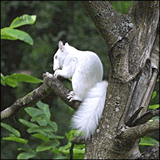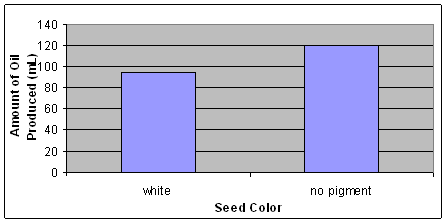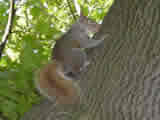
Preview
Material for Exam 4 - Fall 2007
Print
the PDF version (no pictures, better printing)
Gray squirrels (Sciurus carolinensis) are common throughout the Eastern and Midwestern United States. Although this species is normally gray, rare instances of white individuals exist and are considered “lucky” by many people. These white individuals are albinos – meaning that a mutation prevents them from making melanin, the pigment used to color their coat and eyes, which provides camouflage and protection from the sun. Genetic traits for this condition are recessive. Albino squirrels are found much more commonly in urban areas, where populations can be relatively high. For instance, in Olney, Illinois albino squirrels are legally protected from cats, motorists, and squirrel-nappers and over 200 albino squirrels are present within the city limits (5 square kilometer land area).
 source
source source
sourceGray squirrels live outside during a variety of environmental conditions. Their body shape allows them to hold their limbs tightly to their body and form a ball shape and also to stretch their limbs outwards way from their body.
Meerkats are small mammals and members of the mongoose family that typically live in colonies of 20-40 individuals in Southern Africa. Some researchers have documented cases in which human tuberculosis was diagnosed in meerkats. Tuberculosis is contagious among meerkats as it is for humans.
 source
source source
sourceAlso native to Southern Africa are some species of scorpions that produce venom called charybdotoxin, which blocks potassium gates from opening in the neurons. Charybdotoxin (chemical formula = C176H277N57O55S7) is a 37 amino acid protein. The central portion of the charybdotoxin protein consists of: threonine-serine-arginine-glycine-lysine.
 source
sourceWhen you flush something down the toilet – it all goes to the wastewater treatment plant! Since the treatment process doesn’t completely clean the water, wastewater from the Stillwater Sewage Treatment Plant contains a variety of contaminants including:
- Nitrates and phosphates
- PBDEs (polybrominated diphenyl ethers), flame retardants found in clothes and furniture - Many scientists have recently become concerned about PBDEs due to the ability of these compounds to biomagnify.
- Nicotine, excreted from tobacco users – nicotine mimics acetylcholine, a neurotransmitter.
These contaminants are carried by the wastewater into a nearby stream. In the stream there are algae, small insects that eat the algae, and bluegill sunfish that eat the small insects. Scientists are currently trying to figure out if these chemicals are present at high enough levels to cause environmental damage.
The following organisms are the components of a simple food pyramid in a lake and its surroundings. In the table the organisms are given in a random order.
Organism # of individuals
Fish 1,000,000
Snakes 5
Birds 5,000
Algae 10,000,000,000,000,000
Felix & Oscar return:
Felix the cat seems to spend about two-thirds of his summer days taking naps. On one particularly hot August day the as the air temperature rises 104°F (40°C), and you notice that Felix begins breathing more rapidly and panting. Meanwhile, Felix’s housemate Oscar the iguana climbs on a flat rock positioned under a maple tree.
 source
source
 source
sourceMicrobiologists like to grow pathogenic (disease-causing) strains of bacteria in a sterile nutrient broth within tubes or flasks. Most pathogenic bacterial species isolated from human blood grow best at 37° C (98.6° F) which is the normal body temperature of an average person. The flasks of bacteria are usually grown in a 37° C incubator with aeration (shaking in the presence of air). Some bacterial pathogens are facultative anaerobes (i.e., they do not require oxygen)
A scientist adds 50 E. coli bacteria to a one liter of rich growth media. For 10 days she observes that the E. coli grew logistically and that the population was N= 4 x 109 bacteria/liter on days 8, 9 & 10.
The chart below represents the U.S. Census Bureau’s estimates of world population between 1800 and 2000.
WORLD POPULATION GROWTH
|
Year (A.D.) Human
pop. (billions)
1800 0.8
1850 1.0
1900 1.5
1930 2.0
1950 2.4
1960 3.0
1970 3.9
1980 4.5
2000 6.0
|
Many scientists think that, in June of 1908, an asteroid or comet crashed into central Siberia with the destructive impact of 20 megatons of TNT over 1000 square miles of land habitats! In the years following the Siberian impact, a few representatives of surrounding populations of rodents, birds, and trees (as seeds) arrived randomly in the impact area.
 source
source source
sourceFat-tailed dwarf lemurs (Cheirogaleus medius), a type of primitive primate, appear monogamous. The MHC genes determine the antigens found on an individual’s cells and therefore the organism’s immune response. In lemurs the MHC genes also affect body scent. Females are more likely to mate with males that have a scent different from their own. Thus their offspring have a wider range of immune responses than they do.
Helianthus anomalus is a rare species of sunflower adapted to sand dunes in Utah and northern Arizona. In wild populations H. anomalus has a well-developed taproot, the large root that grows down into the earth. A large taproot is beneficial for plants, especially those in the desert, to anchor the plant in loose sand and reach a water source.
In the early 1990s, researchers were particularly interested in the growth of sunflowers to extract sunflower oils. Some studies were performed on the sunflower species Helianthus annuus, Helianthus petiolarus, and Helianthus anomalus. Researchers discovered sunflowers have 34 chromosomes (2n) and there is a connection between the amount of oil produced by a plant and the color of its seeds.
 source
source source
source
 source
source.jpg)
 source
source